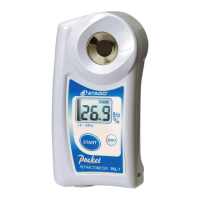1. Inserting Batteries
When inserting batteries for the first time or replacing
batteries, this step should be performed in
an
environment where there
is
relatively low humidity.
(1) Remove the battery case
cover.
Be
sure to remove
the protective tape located
on
the under side of the
cover (Fig.1-1).
(2) Refer to the illustration
located on the back of the
unit. Follow this diagram
to
properly
insert
the
batteries,
noting
the
positive
and
negative
terminals. Insert the two
AAA
alkaline
batteries
provided (Fig.1-2).
(3) After inserting the batteries,
place the battery case cov-
er
on
the slot, aligning the
mark
on
the battery case
cover to the mark
on
the
lower part of the main unit.
Then turn the battery case
cover towards the right
(clockwise), while holding
the center tip of the battery
case cover with your
thumb and index finger
and pressing it down-
wards, until it stops com-
pletely (Fig.1-3, 1-4).
Fi
9
.1-
.
Fig.1-2
+
Fig.1-3
Th~r
~
The
mark
on
1I1e
main
unn
•
Fig.1-4 Position of the battery case cover
CAUTION
~
Open
.C~:
o,o~
>0
w~
-~
[CAUTION]
• Confirm that the battery case cover
is
tightly closed
in
order to prevent ingress
of
liquids coming inside the
unit which causes unstable electronic connection
and
not being able to measure. Turn the cover tightly
after setting it correctly into the instrument.
•
Check
that
the
O-ring
located
on
the
battery
case
cover
is
clean
and
free
of
deformities.
If
the
O-ring
is
dirty
or
deformed, water may enter the instrument causing
damage
to
the
electronic
components
(Fig.1-S).
After
opening
and
closing
the
cover
several
times,
apply
oil
(such
as
Vaseline)
on
the
O-ring
with
a
cotton
swab.
I
'~"
0 . I
.
~o-nng
.
• Battery Power Indicator
:;::::::]II
When the battery power is low, as indicated by the
symbol above, replace with new batteries as soon
as possible.
Use only 1
.SV
AAA batteries.
•
When
inserting batteries for the first time or replacing
batteries, this step should be performed in an
environment where there
is
relatively low humidity.
• Occasionally, the "battery indicator," a character
or
number mark may be present after the instrument
is powered off.
This occurs due to static electricity and is not a
defect in the liquid crystal display (LCD).
When
these
marks
are
present,
there
is
no
additional power drain on the battery.
• Always check the expiration date when purchasing
batteries.
• Perform Zero Setting after replacing the batteries.
2. Zero Setting
[CAUTION]
• Perform Zero Setting each day prior to using the
PAL-1.
• The temperature of the distilled or tap water used
for
zero-setting
should
be
the
same
as
the
ambient
temperature.
If not,
allow
the
water
temperature to adjust to the ambient temperature
before pressing the ZERO key to Zero Set.
• If the ELI* function indicates the [nnn] warning
message on the LCD screen while performing
zero-setting, shade the sample stage with your
hand and press the ZERO key again.
www.GlobalTestSupply.com
Find Quality Products Online at: sales@GlobalTestSupply.com

